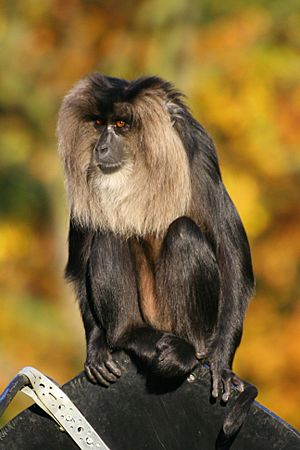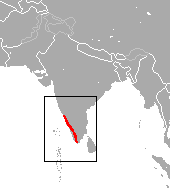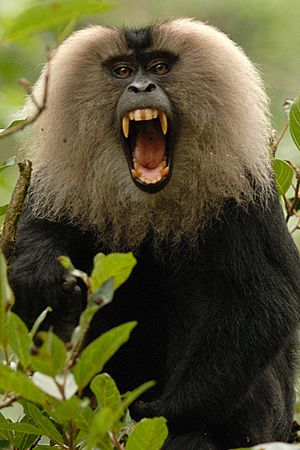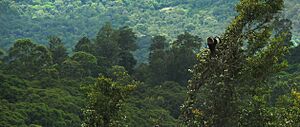Lion-tailed macaque facts for kids
Quick facts for kids Lion-tailed macaque |
|
|---|---|
 |
|
| Conservation status | |
| Scientific classification | |
| Kingdom: | |
| Class: | |
| Order: | |
| Family: | |
| Genus: | |
| Binomial name | |
| Macaca silenus (Linnaeus, 1758)
|
|
 |
|
| Lion-tailed Macaque range | |
The lion-tailed macaque (Macaca silenus) is a type of Old World monkey. It lives in the Western Ghats mountains of India. This monkey gets its name because its tail looks a bit like a lion's tail. It has a black tuft of hair at the end.
Lion-tailed macaques have dark-brown or black fur. They are one of the smaller macaques. They usually weigh between 3 to 10 kg (about 6.6 to 22 pounds). Their body length, from head to tail, is about 45 to 60 cm (18 to 24 inches).
These macaques are diurnal, meaning they are active during the day. They live in rainforests and are excellent climbers. They spend most of their lives high up in the trees. Unlike some other macaques, they tend to stay away from humans. The lion-tailed macaque is one of the rarest primates in the world. Many zoos work together in special breeding programs to help this amazing species survive.
Contents
Physical Features
The lion-tailed macaque has striking black fur. Its most special feature is the silver-white mane around its head. This mane goes from its cheeks all the way down to its chin. It makes the monkey look like it has a beard! In fact, its German name, Bartaffe, means "beard ape." Its face is black and has no hair.
These macaques are considered smaller monkeys. Their body length is about 42 to 61 cm (16.5 to 24 inches). They weigh between 2 to 10 kg (4.4 to 22 pounds). Their tail is about 25 cm (10 inches) long. The black tuft at the end of the tail is more noticeable in males than in females.
Life Cycle and Reproduction
Female lion-tailed macaques are pregnant for about six months. After birth, the baby monkeys drink their mother's milk for about one year. Females can start having babies when they are about four years old. Males become old enough to mate around six years of age. In the wild, these macaques can live for about 20 years. When they live in zoos, they can sometimes live even longer, up to 30 years.
Behavior and Habitat
The lion-tailed macaque is a diurnal animal that lives in rainforests. They are very good climbers and spend most of their time in the upper parts of the forest, called the canopy. They prefer to live in tropical moist evergreen forests. Unlike many other macaques, they usually avoid people.
These monkeys live in groups, much like other macaques. A group usually has 10 to 20 animals. There are usually a few males and many females in each group. They are also very protective of their home area. If another group tries to enter their territory, they will first make loud calls to warn them. If that doesn't work, they might even get into aggressive fights.
Lion-tailed macaques spend a lot of time exploring and finding food. They mostly eat fruits, leaves, and buds from native trees. They also eat insects and small animals. They can adapt to changes in their environment, like when trees are cut down. In such cases, they might start eating other things like seeds, shoots, flowers, and parts of different plants. In the forests of Kerala, some have even been seen eating baby birds and eggs from pigeon nests.
Images for kids
-
A skull preserved at the Naturalis Biodiversity Center in Leiden, Netherlands
See also
 In Spanish: Sileno para niños
In Spanish: Sileno para niños






